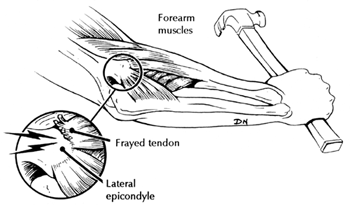Clinical Trials
Tennis Elbow (Lateral Epicondylitis) Study - Surgical
Surgery is normally reserved for chronic conditions that haven't responded to other treatments, with many different suggested surgical techniques. These range from complicated tendon lengthening procedures to simple "nicks" in the tendon through tiny incisions. Again, the best supported surgery at present involves cutting out the damaged part of the tendon, which is usually only a small part of the whole and does not affected movement or strength. Interestingly, all the operations described in the various studies have had success rates reported well over 80%.

The purpose of the study
We are conducting this trial, because all the operations around the elbow appear to have a high success rate, regardless of which part of the problem they address and because one theory is that any type of operation will increase blood flow to the area and therefore increase healing. Our control will be the operation where a small part of the diseased tendon is cut out and we will compare it to an identical procedure, but without cutting out the tendon. We will then compare any difference in the healing and symptoms.
Eligibility for the study
To be eligible for the study, patients need to be over 18, have suffered from tennis elbow for at least six months and have not responded to maximal medical treatment. The exclusion criteria are: previous surgery to the elbow, symptoms that appear referred from a source other than the elbow, painful shoulder or wrist, concurrent pregnancy, previous elbow dislocation of the affected elbow, distal neurological symptoms, inadequate skin coverage and patients unable or unwilling to fulfil the follow-up requirements.
What you can expect if you are a participant
The surgery is a day-only procedure, carried out under local anaesthetic at the elbow, and short acting sedation. A small, 3cm cut is made on the outside of the elbow and the muscles and tendons of the elbow are examined. In patients randomly allocated to one group, we will cut out the diseased part of the tendon, if allocated to the other group, the tendon will be examined, but not cut into. The tissues are then repaired and the skin is closed with a dissolvable, cosmetic stitch.
There are some potential risks associated with this study. Anaesthesia always carries some risk, but patients will be fully monitored throughout the procedure by our anaesthetic consultant. Because tissues are being cut, there is a possibility of bleeding, infection and some loss of skin sensation around the incision site. One study found that a few people lost a few degrees of movement at the elbow, but it did not affect the patients functionally. The risks could be compared to having a skin lesion removed.
Patients will need to wear a sling for a week, although they can and should exercise their wrist and shoulder. The first review is at nine days to check the wound and remove the stitches. If everything is going well, patients are shown some exercises to do over the next few weeks. Most people should be able to return to light duties within three weeks and gentle sport within six weeks. Based on previous experience, most people are able to function fully at four to six months after their operation. Patients' progress will be monitored, with follow up visits at six weeks, then three, six and twelve months.